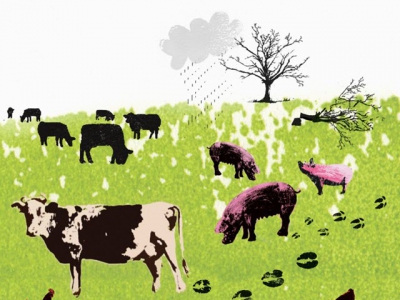Making the most of calcium as a soil and plant nutrient

Despite being a vitally important element for optimal crop production, calcium is often largely undervalued by farmers and agronomists. Plant health expert Heather Raymond explains why this outlook needs to be changed, and gives tips on how to enhance calcium in soils and plants.
It is important for soil managers to ensure that applied calcium is available in a crop’s root zone. Photo: FW Archive
A number of health and growth problems, such as blossom-end rot, in intensive crop production can be attributed to calcium (Ca) deficiency in the plants being cultivated. This is despite Ca being the fifth most abundant element in the Earth’s crust.
Intensive crop farmers who do not effectively address Ca availability in their crops will lose yield and quality, their production costs will increase, and their enterprise profitability will decrease.
Heather Raymond, plant health expert at Tsama Agricultural Agencies, says that without Ca, life as we know it would be impossible.
“Ca is essential for structure in soils, animals and plants, and for the strong growth of both plants and animals. It belongs to the group of secondary nutrients that are generally needed in lesser amounts than nitrogen (N), phosphorous (P) and potassium (K), but are just as important to the crop,” says Raymond.
She adds that Ca is typically found in soils as CaCO3 (calcium carbonate), CaSO4 (calcium sulphate) and apatite.
The effect of Ca in soils is that it flocculates clays and organic matter, thereby increasing soil porosity, improving air and moisture movement through the soil, enhancing soil biology, and promoting root growth within the soil.
Certain Ca compounds also neutralise excess acidity or alkalinity in soils. This helps improve plant roots’ uptake of other nutrients from the soil.
“It is known that soil pH affects the efficiency of N:P:K in soils. Their efficiency is greatly reduced in acidic soils. In extremely acidic soils of water pH 4,5 or less, about 71% of the soil-applied N:P:K fertiliser becomes unavailable for uptake by plant roots,” says Raymond.
“By increasing soil pH to water pH of 5,5, fertiliser efficiency increases to nearly 80% for N and K, and to 50% for P. At neutral water pH of 7,0, fertiliser efficiency should theoretically reach 100%.”
Low soil calcium levels
There are many causes of low Ca levels in some soils, including if the parent rock contained low Ca levels. Low soil Ca levels may also be the result of over-irrigating soils that have a low cation exchange capacity (CEC), causing Ca to leach out of the soil profile.
In this particular case, it is important for the soil manager to regularly monitor the soil’s Ca levels and to appropriately replace any shortfalls.
Raymond adds that excess nitrates and sulphates in soils can also have a negative impact on the quantity and plant-availability of Ca in these soils.
This is because these excess nitrates and sulphates are easily leached from soil, and the negatively charged ions of these two substances can bind to positively charged Ca ions in soil, taking the Ca with them.
The soil manager needs to monitor application rates of nitrates and sulphates to limit unnecessary and costly leaching of important nutrients. Again, where necessary, the soil manager must take steps to replace any resultant Ca shortfalls.
She also explains that another reason why soil Ca levels are reduced by farming practices is due to the continued uptake of Ca by plants and the soil manager then not replenishing the soil with appropriate Ca-based fertilisers.
Raymond says that a good example is the switch from urea to limestone ammonium nitrate (LAN).
LAN is a source of Ca, whereas urea is a straight N product and makes no contribution to soil Ca levels when applied.
Increasing soil calcium levels
“There are four common sources of Ca that farmers can apply to their soils or crop foliage to address soil acidity or to increase Ca availability to plants.
These include calcitic, dolomitic or hydrated lime, gypsum (CaSO4), Ca salts, and new-formulation Ca products. The problem with lime is that it is relatively insoluble, and so it is often not an efficient source of sufficient, readily soluble Ca.
While lime is good for reducing soil acidity, supplementary soluble Ca is often required to meet the immediate crop and soil Ca requirements,” says Raymond.
Gypsum is good for treating sodic soils and is more soluble than lime, but it is still relatively insoluble. Should a soil or crop require immediate Ca availability, it may be best to apply the necessary quantities as a soluble Ca source.
Raymond warns: “Be sure to first have the quality of any gypsum that you want to buy and apply tested independently. Some gypsum being sold in South Africa is downright dangerous. Colleagues and I have found some gypsum sources, when tested, to have an extremely acidic pH of 2,1.”
Ca salts, such as calcium nitrate (CaNO3)2 and calcium chloride (CaCl2), are readily soluble, making them a good source of available Ca in a soil.
It is important to first consult with a trusted fertiliser expert before deciding on which Ca salt is needed. This is because the nitrates and chlorides in these Ca salts may actually be undesirable and detrimental to either the soil or crop quality if not applied appropriately.
Raymond says advances are being made in the development of more user-friendly Ca sources for agricultural soils and crops.
These include liquid limes and Ca sugar complexes that are more soluble, desirably reactive in the soil and in plants, and that make Ca supply to and accessibility in plant root zones less challenging.
Water scarcity
She continues: “Your choice of Ca source should also be influenced by the consideration that South Africa’s freshwater resources are already under tremendous pressure.
For example, as was quoted in Farmer’s Weekly [2 July 2012], it requires 66 000ℓ of water to dissolve 1kg of calcitic lime to achieve a soil Ca level of 100 parts per million. In contrast, it takes 412ℓ of water to dissolve 1kg of gypsum to achieve a soil Ca level of 450ppm.
It requires only 1ℓ of water to dissolve 1kg of CaNO3 to achieve 190 000ppm of Ca in the soil. And some new Ca formulations are already in liquid form, and require no water to achieve 60 000 ppm of Ca in the soil.”
Making Ca bioavailable to plants is essential. Not only does Ca strengthen plants’ cell walls and bind cells together, it is important for cell division and elongation. Plants also need Ca to assist with their uptake and translocation of other important nutrients.
And Ca helps plants to release stress and increase their tolerance to pests and diseases. Finally, Ca helps increase the shelf-life of fresh produce.
Unfortunately, on a scale of 0 to 100 where N = 100 and is fully bioavailable to plants, Ca’s bioavailability score is only four. This makes it extremely difficult for plants to take up Ca from the soil.
So the soil manager needs to create conditions that enhance plants’ abilities to access and utilise this element. Plants’ uptake of Ca from the soil is a passive process and occurs only at the immature tips of growing roots, so soil managers must ensure that crop root growth is constant and vigorous for constant Ca uptake.
Raymond adds that once Ca is in a plant’s root system, the plant then needs sufficient water to effectively translocate the Ca using transpiration pull, via the xylem system, throughout the rest of the plant.
“When a plant starts to produce fruit, the plant’s transpiration pull is to the newly forming fruit, where massive cell division is taking place. Once cell division ceases, Ca uptake in the fruit reduces dramatically and the Ca concentration in the fruit is diluted as a result of the fruit’s expansion,” she says.
“To ensure that fruit receives sufficient Ca, farmers should consider the application of well-timed direct foliar sprays of this element to the crop plants.”
When in doubt, speak to an expert
Raymond stresses that these Ca-based foliar sprays must be applied at the right times and the correct rates.
They must also be safe to use and should not be antagonistic to other nutrients in the plant and soil.
It is important for the farmer to first consult with relevant experts to find the most appropriate and effective Ca-based foliar spray products, and for advice on when and how to use these for optimal results.
Related news
Tools

Phối trộn thức ăn chăn nuôi

Pha dung dịch thủy canh

Định mức cho tôm ăn

Phối trộn phân bón NPK

Xác định tỷ lệ tôm sống

Chuyển đổi đơn vị phân bón

Xác định công suất sục khí

Chuyển đổi đơn vị tôm

Tính diện tích nhà kính

Tính thể tích ao



 Advances in ruminant environmental impact reductions
Advances in ruminant environmental impact reductions  Stocking rate effects on growing juvenile sunshine bass
Stocking rate effects on growing juvenile sunshine bass